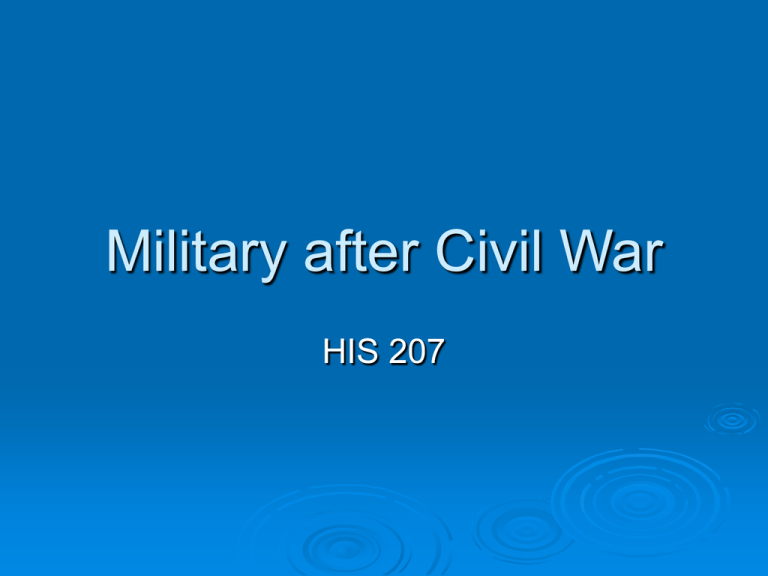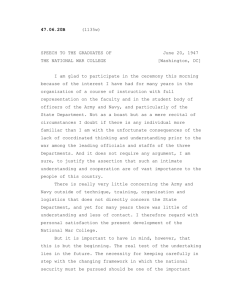Military after Civil War HIS 207
advertisement

Military after Civil War HIS 207 Civil War is Over Great volunteer army was quickly demobilized May 1865—1 million volunteers in army November—800,900 men released from service By 1866—only 11,000 volunteers remain By 1876-the authorized size was reduced down to 27,500 Government Vision in post-war era White House and Congress saw no need for a large regular army Believed that nation was well served by volunteer force in Civil War No “real” enemies on the horizon Prompts question—”Why do we need an army?” Military spending channeled in other directions. What are roles of the post-war army? Difficult to accomplish any objectives with very small force spread out over many bases. Reflected political realities—think of today Large unit organization was non-existent Nothing larger than a regiment Uses of the Army in the post-war period. Reconstruction/Occupation Indian of the South wars Civil Disturbances/Strikebreaking Reconstruction (1865-1876) Greatly disliked task Wanted to avoid politics • Voter registration drives, arranging elections, installing officials Too few troops to truly “occupy” the South. • Little support in North for occupation Successful in establishing the Civilian government Not so successful in protecting freed blacks Indian Wars From 1865 to 1891, there were 13 different campaigns and at least 1,000 separate engagements with Native American warriors. Another job the army accepted reluctantly Likely to be criticized regardless of the outcome. Generally called in to resolve issues created by settlers or Indian Bureau. Army Tactics Developed effective small units tactics to deal with highly mobile tribes on the Great Plains. Vulnerable to attack by larger force—Custer Frequently outgunned by the Indians Eventually able to overcome these limitations Frontier Life of army Very different from the “Hollywood” image Life was lonely and remote Few men brought their families Most forts were really villages with a few simple buildings-some walled, others not. Rarely provided with adequate food Frequently not paid for long stretches Conditions little better than those encountered by Native Americans George Crook Most successful of the Army’s Indian fighters. Also most knowledgeable of the ways of the Indians Men traveled light-rode hard Organized Indians as combatants-one tribe fighting another End of Era By late 1870’s, Indian power was broken on the Plains With defeat of the Sioux, last of the major tribes was defeated. Army proved generally effective in establishing peace in the west with a minimum of bloodshed Civil Disturbances Industrial growth prompt labor disputes National Guard was expected to deal with local issues Ill-prepared—under trained and sympathetic with Some army officers see industrial warfare as new role for army Way of gaining public support Strike of 1877 Railroad strike National Guard fails to quell riots Federal troops called out Confusing command structure • Civilians giving orders Able to intimidate strikers & restore order Good for congressional support of army National Guard Despite failures in labor disputes, a strong push for a citizen-soldier military force remains. Organized militia under state control saw more strike duty during 19th century. Fear of revolt-need to improve and better arm militias 1879-National Guard Association Between 1881 and 1892 every state revised its military code Presented a challenge to the continued existence of regular forces. Navy Developments Physically disintegrates after the war Technological advances of the Civil War are rejected Return to wooden sailing ships • Gave Navy maximum range with minimum support Navy that Congress wanted low cost force Anti-expansionistic Simply interested in promoting American trade Role of Navy Commerce Protection Showing the flag Stopping foreigners from attacking American interests Navy was well suited to this role. Don’t need steel and steam vessels Changing World Situation in late 19th century Global competition increases in the late 19th century European powers become increasingly imperialistic. Risk emerges that markets previously open to the U.S. will be closed. China Africa Pacific Movement for Change Voices begin to call for a change in naval strategy For markets to remain open, the navy needs a force capable of competing with Major European powers 1883—ABCD ships Steel ships with sails Ship names selected for maximum political support Small, poorly designed and under-armored— important first step Leaders for Naval Change Alfred Thayer Mahan Benjamin Tracy—Secretary of Navy Proposes a radical increase in the size of the navy. Needs to sell to Congress • Ships that will protect America’s shores • Coastal defense was politically marketable Compromise • Coastline sea-going battleships-5,000 mile range • No sails Samoa Incident(1889) Dispute with Germany and Britain over control of Samoa (SW Pacific) Naval forces from all three countries squared off in Apia harbor War prevented by massive hurricane Settlement reached—US gains naval base at Pagopago. US force, 3 wooden ships, ill-prepared to fight ships from major European powers True Blue Saloon Incident(1891) USS Baltimore in Valparaiso, Chile Drunken brawl—2 deaths Appears that war may break out with Chile Congress and President realize that victory is far from assured Chile has Navy almost equal to US Navy Forces government to serious consider further expansion Expansion in 1890’s Naval Appropriations Act of 1890 Authorized the construction of three battleships— Indiana, Massachusetts and Oregon • 1st true capital ships of the American navy Heavily armored Powerfully gunned (13inch main batteries) • World Class vessels By time of Spanish American War, Navy was well on its way to being a world power. Navy 1865-1898 Never faced the same challenges as the army Always had accepted mission. Commerce protection Showing the flag changing world in late 19th century, Naval leadership skillfully positioned itself to evolve. Sp-Am war will push Navy to forefront With



